Introduction
NEMO Airpins are ultralight aluminum stakes designed with notches that function as a three-point locking system. This review is not comprehensive – but I did measure the holding power of the stake and share my experience with it in a limited number of backcountry environments.
NEMO markets the self-locking design of these stakes as a means of eliminating the need to use knots or other tensioners for guy-lines. A locking system built into a stake is somewhat innovative, and in theory, provides several practical benefits to ultralight hikers.
NEMO Airpins retail for $9.95 for a set of two or $18.95 for a set of four.
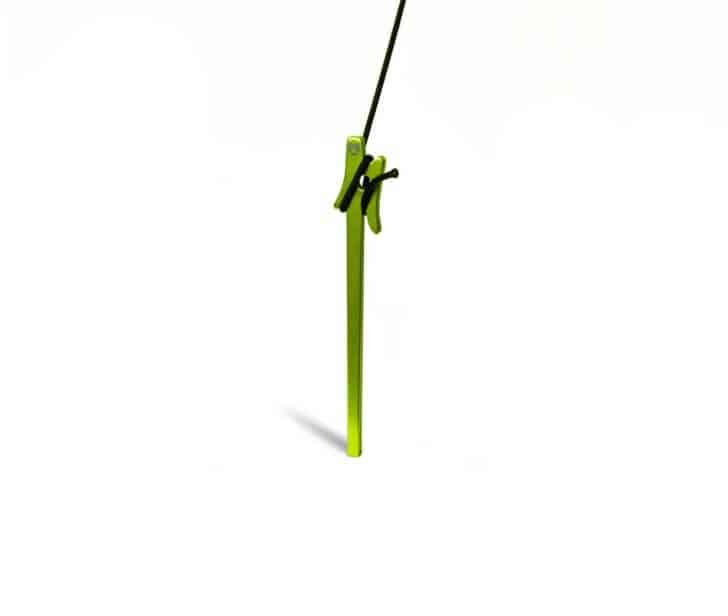
Category Overview
Tent stakes are a surprisingly complex category of backpacking gear. Will Rietveld’s tent stake overview provides an exhaustive analysis of several models, their holding power, and other technical details. I used Will’s method (detailed below) to determine the Airpin’s holding power.
The most common designs of tent stakes are nail, y-stake, v-stake, tubular, and shepherd hook. Examples of this, in respective order, are the Vargo Titanium Nail Peg, MSR Groundhog (and the lighter Groundhog Mini), Vargo Titanium Ascent, MSR Carbon Core, and REI Co-op Aluminum Hook (as well as lighter designs made of titanium).
Features and Specifications
Features
- Self-locking design
- Tapered shaft
- Lanyard hole
Specifications
- Weight: 0.35 oz (10 g)
- Total length: 6 in (15.24 cm)
- Effective length: 4.5 in (11.43 cm)
- Material: Aircraft-grade 7075 aluminum
Performance Notes
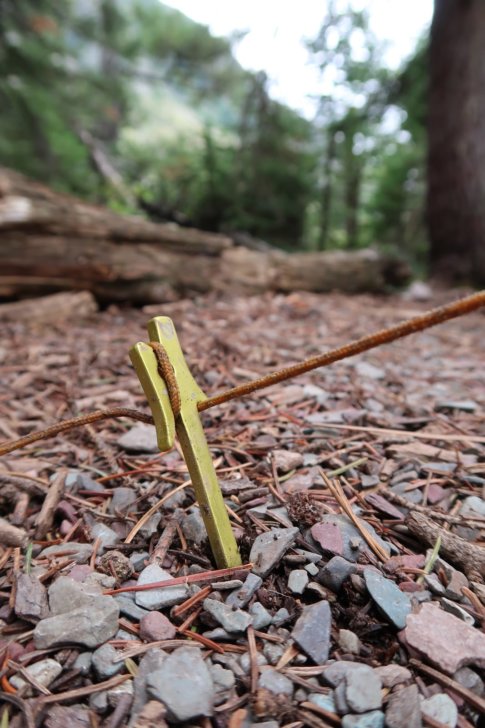
I used the NEMO Airpins in a variety of campsites and conditions: designated backcountry campsites in Glacier National Park with compacted soils, grassy campsites in subalpine forests in the Beaverhead-Deerlodge National Forest, and rocky campsites at treeline in the Bitterroot National Forest. I used these takes to secure the guy-lines for my Six Moon Designs Lunar Solo shelter, MSR Hubba NX tent, and MSR E-Wing (now discontinued) tarp in a variety of weather conditions. The guy-lines on each shelter were Kelty Triptease, a 1.5 mm nylon cord with a Dyneema core. I secured the guylines to the webbing with a bowline knot.
Holding Power and Insertion
These stakes were easy to insert into all of the ground types I encountered, including rocky soil. There were instances where I needed a stone to pound the Airpins into the rockiest sections of ground, but I found that this threshold was reached later than with other stake designs I’ve used (specifically MSR Groundhogs). In most circumstances, a firm push was all I needed to drive the stake into the ground to its full effective length. Slightly more than 1.5 inches (3.81 cm) of the Airpins must be left above ground to facilitate wrapping the cord through the self-locking notches.
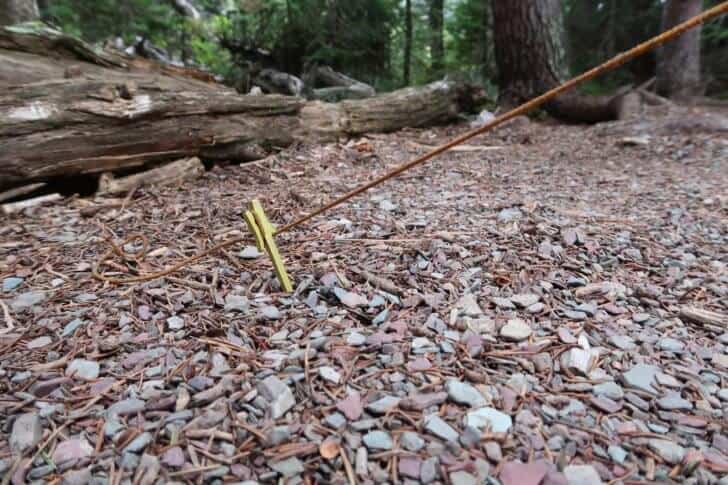
I used Will Rietveld’s stake holding-power test (described here) to determine holding power for the NEMO Airpins. Here’s a summary of the test:
- I uniformly inserted the stakes at a 45-degree angle and pulled them out at a 45-degree angle.
- I used a 110 lb (50 kg) digital fish scale to measure stake holding-power.
- I chose two contrasting ground conditions to test the stakes: a) moist sod, and b) a dry, compacted forest campsite. In each case, all the tests were performed within a 100 ft² (30 m²) area to keep ground conditions as uniform as possible.
- I drove each stake until the attached 1.5 mm cord was pinned to the ground.
- I attached the digital fish scale to a loop at the stake’s head.
- I pulled the stake out of the ground at a 45-degree angle by applying a steadily increasing force.
- In each test, I noted the highest reading on the scale before the stake came out of the ground.
- I repeated each test six times.
The holding power of these stakes was 36 in moist sod and 28 at a compacted forest campsite. This result was the second-lowest of any stake in our data set (see Will’s original article for more comparisons and some context for this performance score).
I believe that the relatively short effective length of the Airpin contributed to its low holding power. It is likely that its nail-like design also contributed to this lack of holding power.
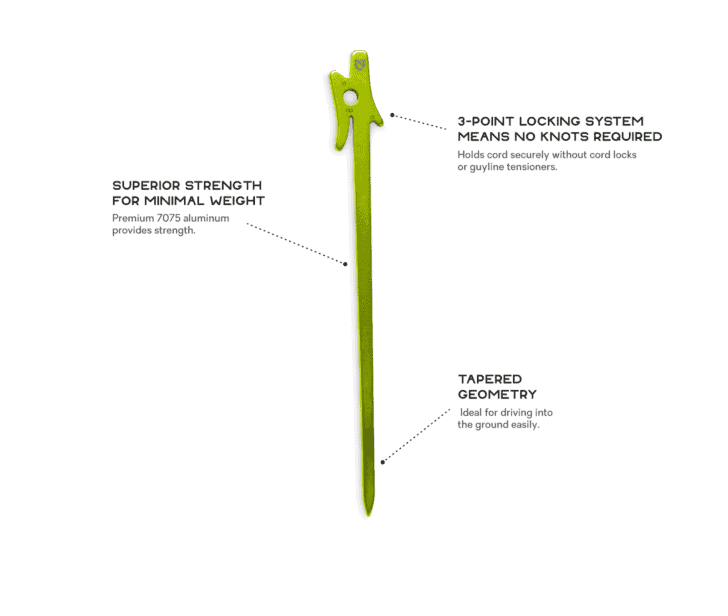
Self-locking Notch
The self-locking notch was easy to use, and dots indicate in which order to wrap the cord (one dot for the first, two dots for the second, three dots for the third). The process is intuitive and the instructions clear. While this feature was novel, I did not find that it greatly aided in the tensioning process. It was ideal for securing guy-lines when tension wasn’t paramount, but the fact that the guy-line had to be removed each time a line needed re-tensioning was a bit frustrating. Whereas with a LineLoc device or a simple taut-line hitch, you can dial in the tension more easily and without having to start from scratch.
I used the NEMO Airpins in windy conditions, rainy conditions, and rainy and windy conditions, and they effectively held the tension on my various shelters. However, and as with any stake, once the fabric of the shelter begins to sag, this impacts the tension. Having to remove the guy-line from the Airpin to re-tension was not a big deal in the conditions I experienced, and with the shelters I was using. But I could see this being an issue in a major thunderstorm, as re-tensioning with the Airpin reduces the structural integrity of the rest of the shelter. This scenario was theoretical in my testing, but is worth noting. With LineLocs and taut-line hitches, the tension can be increased without having to remove the guy-line completely from the stake.
Compared To…
The self-locking notch is an innovation that, to the best of my knowledge, is only found on the NEMO Airpin. This unique feature makes a direct comparison to other tent stakes a bit difficult. So we decided to compare the Airpins a select group of stakes from Wills original article: the lightest (HMG Shepherd Hooks), the best holding power (MSR Groundhogs), and one with a similar nail-like design (Vargo Titanium Nail Pegs) Holding power data for the compared stakes is drawn from Will’s article.
| Stake | NEMO Airpins | HMG Titanium Shepherd Hooks | MSR Groundhogs | Vargo Titanium Nail Pegs |
|---|---|---|---|---|
| Length | 6 in (15 cm) | 6.5 in (17 cm) | 7.5 in ( 19 cm) | 6 in (15 cm) |
| Weight | 0.35 oz (10 g) | .3 oz (9 g) | .5 oz (14 g) | .6 oz (17 g) |
| Material | 7075 aluminum | titanium | Easton aluminum | titanium |
| Holding Power (moist sod) | 36 lbs | 31 lbs | 64 lbs | 40 lbs |
| Holding Power (Compacted Forest Campsite) | 28 lbs | 24 lbs | 63 lbs | 32 lbs |
| MSRP | $18.95 (4) | $15.00 (4) | $2.95 (1) | $4.50 (1) |
Examination of this table reveals the NEMO Airpin is neither the best or worst in any category (except for price – they are the most expensive stakes in our table). While they are relatively light, Airpins also have relatively low holding power (as described earlier). Given this, your opinion of how the Airpins stack up against other stakes is likely to hinge on how convenient you find their unique locking system.
Commentary

Overall, I found these stakes to be useful and to serve their intended purpose adequately. I will continue to use them in three-season conditions with my shelters. Although I do have reservations about their performance and stability in severe weather conditions, I am impressed enough to give them the benefit of the doubt for now.
The Nemo Airpin’s chief strength is its lightweight design and easy insertion – more so, in my opinion, than the self-locking notch. The self-locking notches, while functional, seemed to be a bit of a “solution in search of a problem,” since LineLocs add almost negligible weight to guy-lines, and knots add nothing.
Airpins could be helpful with shelters and tarps that don’t come with LineLocs on their guy-lines. They are also useful for quickly securing guylines if a tautline knot is already tied on the guyline. Backpackers who like to quickly secure guy-lines might find Airpins useful in most conditions. For those already using LineLocs, taut-line hitches, or shelters where guy-lines are not crucial would likely not get much value by adding NEMO Airpins to their kit.
Product Strengths and Limitations
Strengths
- Lightweight
- Easy to insert and remove
- Allows for quick securing of guy-lines with ability to hold initial tension
Limitations
- Low holding power
- Limited effective length
- Self-locking notches not well-suited for fine-tuning when compared to other options
Where to Buy
- You can buy NEMO Airpins at REI.
Related Content
- Read more about what our community is saying about tent stakes.
Disclosure
Updated November 7, 2019
- Product(s) discussed in this article may have been purchased by the author(s) from a retailer or direct from a manufacturer, or by Backpacking Light for the author. The purchase price may have been discounted as a result of our industry professional status with the seller. However, these discounts came with no obligation to provide media coverage or a product review. Backpacking Light does not accept compensation or donated/discounted products in exchange for guaranteed media placement or product review coverage.
- Some (but not all) of the links in this article may be “affiliate” links. If you click on one of these links and visit one of our affiliate partners (usually a retailer site), and subsequently place an order with that retailer, we receive a small commission. These commissions help us provide authors with honoraria, fund our editorial projects, podcasts, instructional webinars, and more, and we appreciate it a lot! Thank you for supporting Backpacking Light!
- Read about our approach to journalistic integrity, product reviews, and affiliate marketing here.

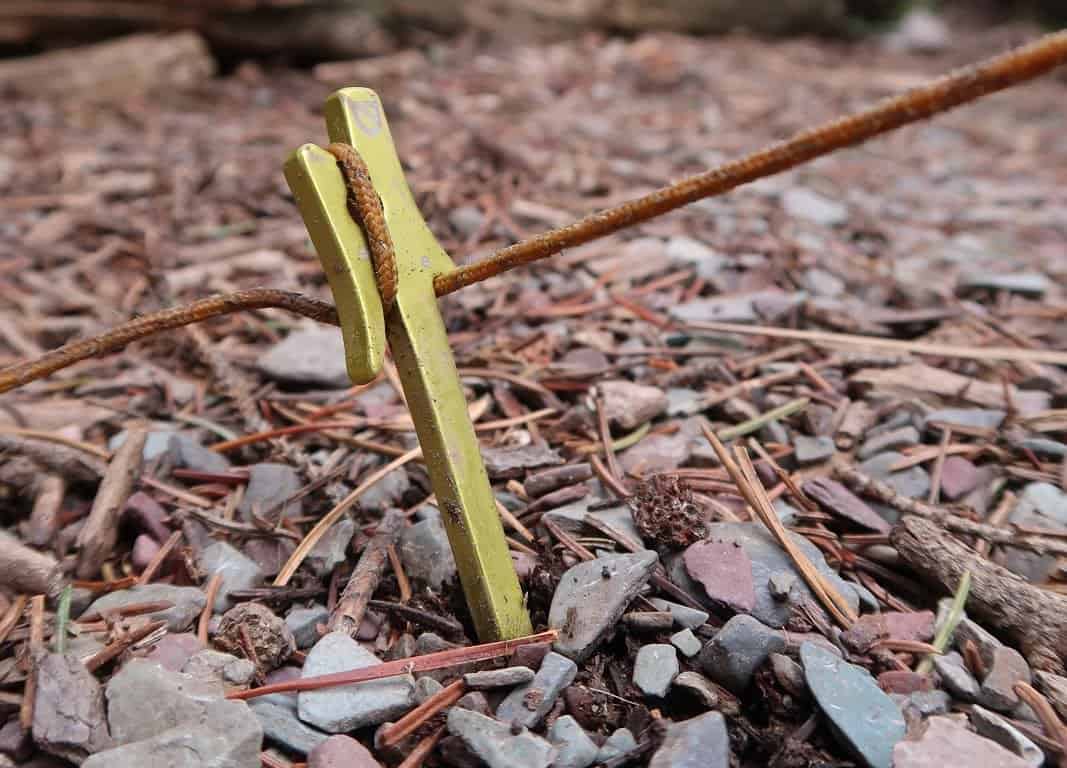


Home › Forums › Nemo Airpin Stake Review